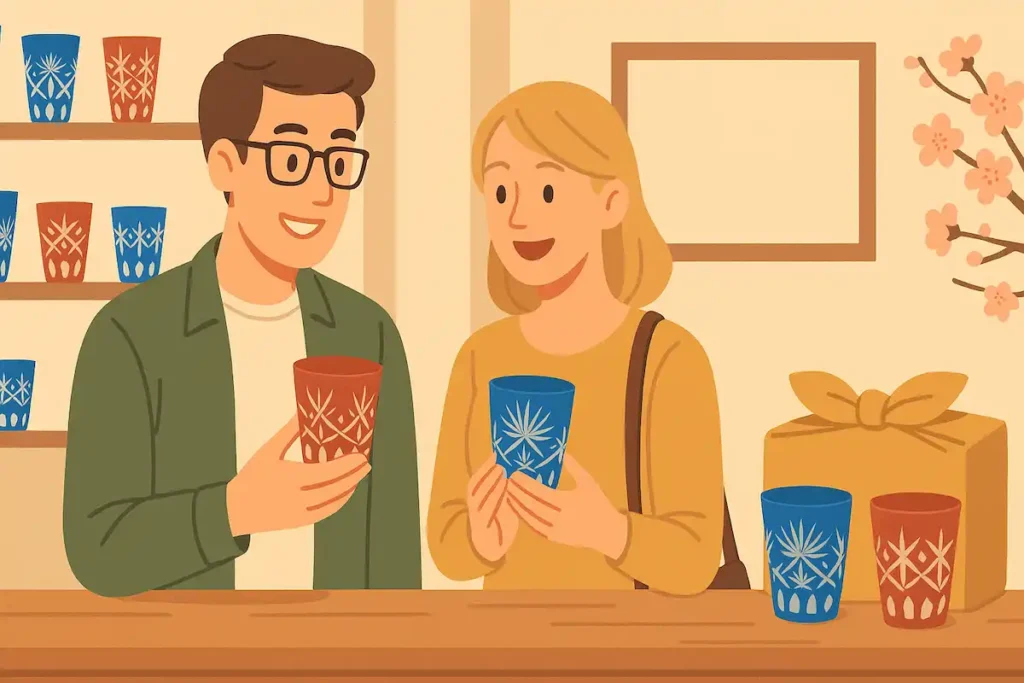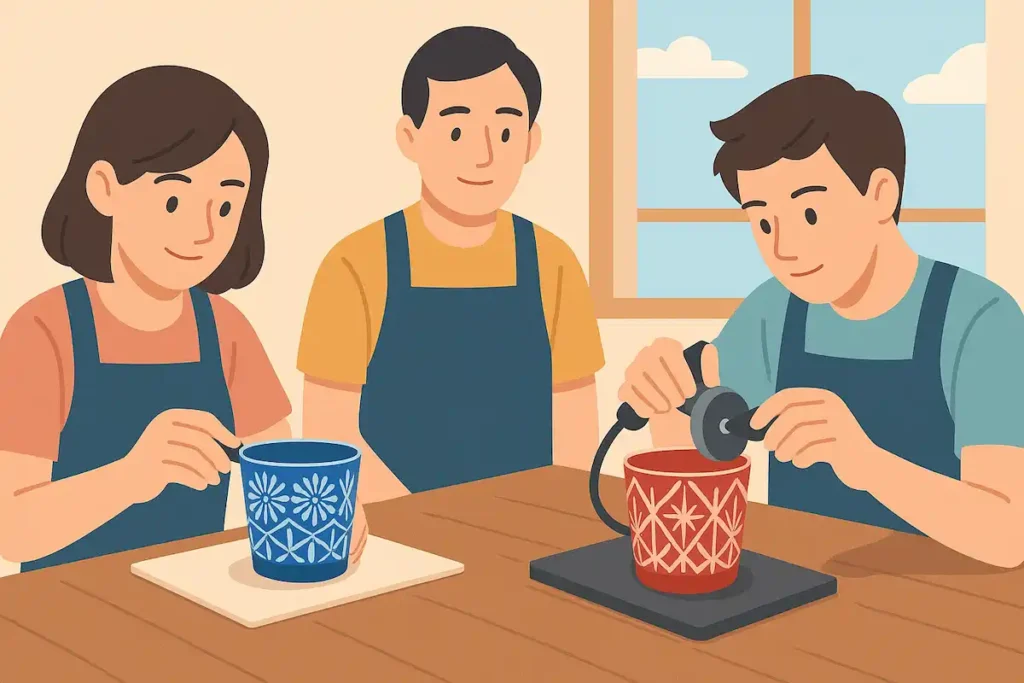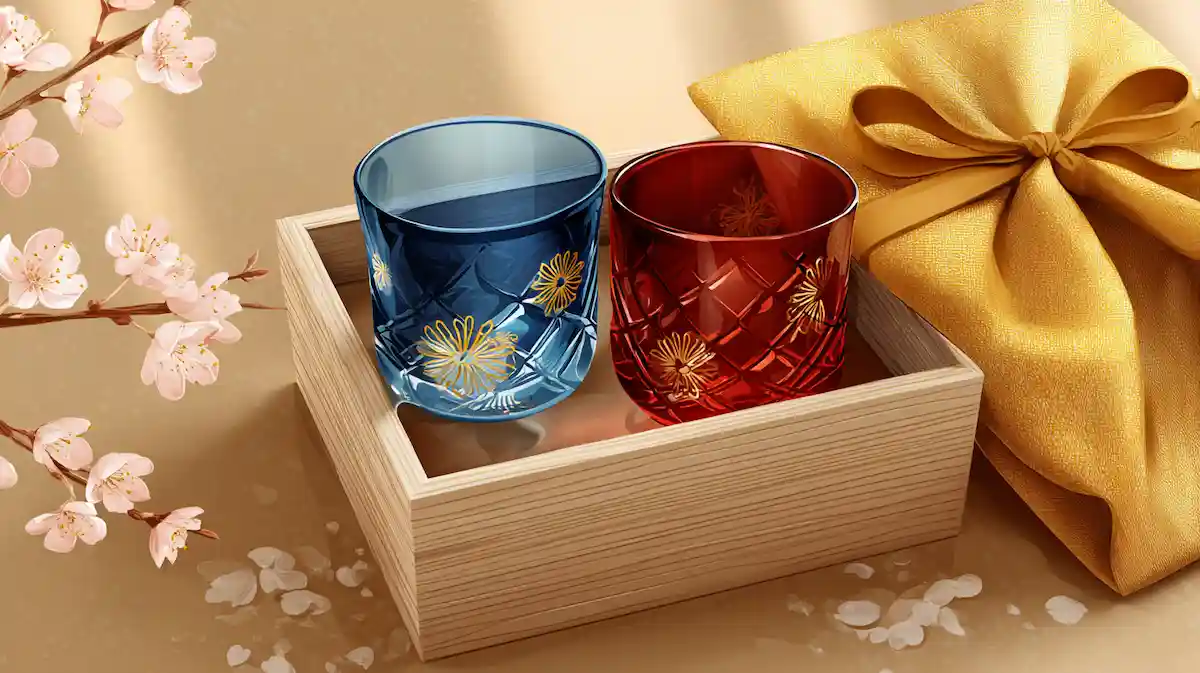江戸切子を英語で説明・紹介するための基本情報と、英会話に役立つ表現をシンプルでわかりやすい英語で紹介します。
英会話ダイアローグ・概要・10の質問を通して、江戸切子に関する英語表現を学びます。
英語
英会話ダイアローグを読む前に知っておくと良い前提知識と情報です。
- 江戸切子の基本情報
- 1834年頃、江戸で職人がガラスに模様を彫ったのが始まり
- 東京都の伝統工芸品で、ガラスの表面に細かな幾何学模様を彫刻する技法
- 透明なガラスや色ガラスに職人が手作業でカットを入れ、光の屈折によって美しく輝く
- 文化的意味と使用法
- 実用性と美しさを兼ね備えた工芸品
- 日常使いの酒器や花瓶として使われる一方、贈り物や記念品としても珍重
- 伝統文様には縁起の良い意味が込められており、日本人の美意識を表現
- 代表的な模様
- 菊つなぎ:菊の花を連ねた模様、長寿や繁栄を象徴
- 麻の葉:麻の葉をかたどった模様、成長や健康を象徴
- 矢来(やらい):竹や木を斜めに組んだ垣根のような模様、防御や安定を象徴
- 人気と現代の展開
- 国内での人気:結婚祝い、記念日の贈り物として人気
- 観光客に人気:東京土産や体験工房として注目
- 海外での評価:ニューヨークやパリの展示会でも紹介され、日本を代表するガラス工芸として高く評価
- 現代的な挑戦:インテリアやジュエリーなどモダンなデザインにも応用
2人が江戸切子について話しています。
江戸切子の歴史、職人の技法、文様の特徴や意味、魅力や人気などを話題にしていませす。
会話 / dialogue

Hey Key, I came across some Edo Kiriko glasses the other day, and they looked stunning. Do you know much about them?

Oh, Edo Kiriko? Yes, that’s a traditional glass craft from Tokyo. It has a long history and is quite famous.

Really? I just thought they were beautiful glasses. When did this craft actually begin?

It started around 1834 in Edo, which is today’s Tokyo. A craftsman named Kagaya Kyūbei first began cutting patterns on glass.

So it has been around for nearly 200 years! What makes Edo Kiriko different from other glassware?

The main feature is the delicate cut patterns. They are carved into clear or colored glass, often using a special technique called “layered colored glass.”

Oh, I think I saw red and blue glass with patterns. They looked so shiny.

Exactly! The cuts reflect and bend light. That’s why Edo Kiriko sparkles like a jewel, and it changes its look from different angles.

That’s amazing. Are there specific designs that are common in Edo Kiriko?

Yes, patterns like chrysanthemum, hemp leaf, and yarai, which looks like a bamboo fence, are very popular. Each design has a traditional meaning, like health, beauty, or good luck.

I like how it’s not just decoration but also carries cultural meaning.

Right, and every piece is handmade. Craftsmen use special skills to keep the cuts even and precise. It takes years of training to master it.

Wow, that must be tough. So each glass is actually unique, isn’t it?

Exactly. No two pieces are the same, which makes them even more special.

Besides their beauty, how are these glasses used in daily life?

People use them as sake cups, drinking glasses, or vases. They’re practical, but at the same time, they’re admired as art.

So they combine function and beauty. That sounds very Japanese.

Yes, that’s part of their charm. Edo Kiriko represents the Japanese sense of aesthetics—bringing art into daily life.

Are they still popular today, or are they just for collectors?

They are very popular. In Japan, they’re chosen as gifts for weddings or anniversaries. Tourists also love them as souvenirs from Tokyo.

I can see why. They’d make a wonderful present. Do people outside Japan know about Edo Kiriko too?

Definitely. Edo Kiriko has been displayed at exhibitions in New York and Paris. It’s recognized as one of Japan’s finest glass crafts.

Interesting. I didn’t realize it had international fame.

And it’s not only about tradition. Today, designers also create modern Edo Kiriko pieces for interior decoration or even jewelry.

That makes me want to try using it every day, not just keep it on a shelf.

You should! And if you’re really interested, some workshops in Tokyo let you experience glass-cutting yourself.
概要(江戸切子とは?歴史・模様・魅力・人気)
「江戸切子」について、理解を深めるための「英語での概要」です。
江戸切子

History
Edo Kiriko is a traditional Japanese glass craft that started in Edo, today’s Tokyo, around 1834. A craftsman named Kagaya Kyūbei first began cutting patterns into glass, and this new style soon spread. Over time, Edo Kiriko became one of Japan’s most famous crafts. In 1985, it was named a traditional craft of Tokyo, and in 2002, it was recognized as a national traditional craft of Japan.
Features
The main feature of Edo Kiriko is the delicate cut patterns. Craftsmen carve designs into clear or colored glass, often using “layered colored glass.” Popular patterns include chrysanthemum, hemp leaf, and yarai, which looks like a bamboo fence. These designs are not only beautiful but also carry cultural meanings, such as health, beauty, or good luck.
Charm
Edo Kiriko is special because it shines like a jewel. When light hits the glass, the cuts reflect and bend it, creating different looks from every angle. Each piece is handmade, so no two are the same. This makes every item unique. Edo Kiriko is both useful and artistic. People use it as sake cups, drinking glasses, or vases, but it is also admired as art.
Popularity Today
Edo Kiriko is still very popular. In Japan, it is often chosen as a gift for weddings or anniversaries. Tourists love to buy it as a Tokyo souvenir, and some workshops let visitors try glass-cutting themselves. Abroad, Edo Kiriko is shown in exhibitions in places like New York and Paris. Today, designers also make modern Edo Kiriko for interior decoration and even jewelry, so it continues to evolve while keeping tradition alive.
10の質問(江戸切子の基本知識)
「江戸切子」について、理解を深めるための「英語での10の質問」です。
1: What is Edo Kiriko?
Edo Kiriko is a traditional Japanese glass craft that started in Tokyo around 1834. It is famous for its delicate cut patterns.
2: Who first made Edo Kiriko?
A craftsman named Kagaya Kyūbei began cutting patterns into glass in Edo, which is today’s Tokyo.
3: What is the main feature of Edo Kiriko?
The main feature is the fine cut patterns that reflect and bend light, making the glass sparkle like a jewel.
4: What kind of glass is used?
Craftsmen use clear glass and colored glass, often with a special method called layered colored glass.
5: What are common patterns in Edo Kiriko?
Popular patterns include chrysanthemum, hemp leaf, and yarai, which looks like a bamboo fence.
6: Why is each piece unique?
Every Edo Kiriko item is handmade, so no two pieces are exactly the same.
7: How is Edo Kiriko used?
People use it as sake cups, drinking glasses, or vases. It is both practical and artistic.
8: Is Edo Kiriko still popular today?
Yes, it is popular in Japan as gifts for weddings or anniversaries, and tourists buy it as souvenirs.
9: Is Edo Kiriko known outside Japan?
Yes, it is shown in exhibitions in places like New York and Paris and is respected as a fine Japanese craft.
10: Can people experience Edo Kiriko today?
Yes, some workshops in Tokyo offer classes where visitors can try glass-cutting themselves.

和訳付
会話 / dialogue

Hey Key, I came across some Edo Kiriko glasses the other day, and they looked stunning. Do you know much about them?
ねえキー、この前、江戸切子のグラスを見かけたんだけど、すごくきれいだったんだ。君は詳しい?

Oh, Edo Kiriko? Yes, that’s a traditional glass craft from Tokyo. It has a long history and is quite famous.
ああ、江戸切子ね?それは東京の伝統的なガラス工芸だよ。歴史も長いし、かなり有名なんだ。

Really? I just thought they were beautiful glasses. When did this craft actually begin?
そうなんだ!ただきれいなグラスだと思ってたよ。いつ頃から始まったの?

It started around 1834 in Edo, which is today’s Tokyo. A craftsman named Kagaya Kyūbei first began cutting patterns on glass.
1834年頃、江戸、つまり今の東京で始まったんだ。加賀屋久兵衛っていう職人が初めてガラスに模様を彫ったんだよ。

So it has been around for nearly 200 years! What makes Edo Kiriko different from other glassware?
じゃあ、もう200年近くも続いてるんだ!普通のガラス製品と何が違うの?

The main feature is the delicate cut patterns. They are carved into clear or colored glass, often using a special technique called “layered colored glass.”
一番の特徴は繊細なカット模様なんだ。透明や色ガラスに彫り込むんだけど、特に「色被せガラス」っていう技法がよく使われるんだよ。

Oh, I think I saw red and blue glass with patterns. They looked so shiny.
ああ、赤や青のガラスで模様が入ったのを見たよ。すごく輝いてた。

Exactly! The cuts reflect and bend light. That’s why Edo Kiriko sparkles like a jewel, and it changes its look from different angles.
その通り!カットが光を反射したり屈折させたりするから、宝石みたいにきらめくんだ。角度によって見え方も変わるんだよ。

That’s amazing. Are there specific designs that are common in Edo Kiriko?
すごいね。江戸切子でよく使われるデザインってあるの?

Yes, patterns like chrysanthemum, hemp leaf, and yarai, which looks like a bamboo fence, are very popular. Each design has a traditional meaning, like health, beauty, or good luck.
うん、菊つなぎや麻の葉、それから竹垣みたいに見える「矢来(やらい)」なんかが有名だよ。それぞれ健康や美しさ、縁起の良さを表しているんだ。

I like how it’s not just decoration but also carries cultural meaning.
ただの飾りじゃなくて、文化的な意味もあるのがいいね。

Right, and every piece is handmade. Craftsmen use special skills to keep the cuts even and precise. It takes years of training to master it.
そうそう。しかも全部手作りなんだ。職人は模様を均一に、正確に彫る技術を持っていて、習得するのに何年もかかるんだよ。

Wow, that must be tough. So each glass is actually unique, isn’t it?
へえ、大変そうだね。じゃあ、一つひとつが全部違うってこと?

Exactly. No two pieces are the same, which makes them even more special.
その通り。同じものは一つもなくて、それがまた特別なんだ。

Besides their beauty, how are these glasses used in daily life?
見た目の美しさ以外に、普段はどうやって使うの?

People use them as sake cups, drinking glasses, or vases. They’re practical, but at the same time, they’re admired as art.
酒器やグラス、花瓶として使うんだよ。実用品でもあるし、同時に芸術品としても楽しまれてるんだ。

So they combine function and beauty. That sounds very Japanese.
なるほど、実用性と美しさの両方を持ってるんだね。すごく日本的だな。

Yes, that’s part of their charm. Edo Kiriko represents the Japanese sense of aesthetics—bringing art into daily life.
うん、それが魅力のひとつなんだ。江戸切子は「日常に美を取り入れる」という日本の美意識を表しているんだよ。

Are they still popular today, or are they just for collectors?
今でも人気があるの?それともコレクター向けなの?

They are very popular. In Japan, they’re chosen as gifts for weddings or anniversaries. Tourists also love them as souvenirs from Tokyo.
今も人気だよ。日本では結婚祝いや記念日の贈り物に選ばれるし、観光客にも東京のお土産としてすごく人気なんだ。

I can see why. They’d make a wonderful present. Do people outside Japan know about Edo Kiriko too?
それも納得だな。贈り物にぴったりだよね。日本以外でも知られてるの?

Definitely. Edo Kiriko has been displayed at exhibitions in New York and Paris. It’s recognized as one of Japan’s finest glass crafts.
もちろん。ニューヨークやパリの展示会でも紹介されているし、日本を代表するガラス工芸として評価されているよ。

Interesting. I didn’t realize it had international fame.
へえ、そんなに国際的に有名だとは知らなかったよ。

And it’s not only about tradition. Today, designers also create modern Edo Kiriko pieces for interior decoration or even jewelry.
伝統だけじゃなくて、最近はデザイナーがモダンな江戸切子も作っていて、インテリアやジュエリーにも使われているんだ。

That makes me want to try using it every day, not just keep it on a shelf.
それなら、棚に飾るだけじゃなくて、毎日使ってみたくなるね。

You should! And if you’re really interested, some workshops in Tokyo let you experience glass-cutting yourself.
ぜひそうしたらいいよ!もし本当に興味があるなら、東京にはガラスのカット体験ができる工房もあるんだ。
概要(江戸切子とは?歴史・模様・魅力・人気)
江戸切子

History
Edo Kiriko is a traditional Japanese glass craft that started in Edo, today’s Tokyo, around 1834. A craftsman named Kagaya Kyūbei first began cutting patterns into glass, and this new style soon spread. Over time, Edo Kiriko became one of Japan’s most famous crafts. In 1985, it was named a traditional craft of Tokyo, and in 2002, it was recognized as a national traditional craft of Japan.
江戸切子は、1834年頃に江戸、つまり現在の東京で始まった日本の伝統的なガラス工芸です。加賀屋久兵衛という職人が初めてガラスに模様を彫り、この新しいスタイルはすぐに広まりました。やがて江戸切子は日本を代表する工芸のひとつとなりました。1985年には東京都の伝統工芸品に、2002年には国の伝統的工芸品に指定されました。
Features
The main feature of Edo Kiriko is the delicate cut patterns. Craftsmen carve designs into clear or colored glass, often using “layered colored glass.” Popular patterns include chrysanthemum, hemp leaf, and yarai, which looks like a bamboo fence. These designs are not only beautiful but also carry cultural meanings, such as health, beauty, or good luck.
江戸切子の主な特徴は、繊細なカット模様です。職人は透明ガラスや色ガラスに模様を彫り込み、とくに「色被せガラス」という技法がよく使われます。代表的な模様には、菊つなぎ、麻の葉、そして竹垣のように見える矢来(やらい)があります。これらの模様は美しいだけでなく、健康、美しさ、幸運など文化的な意味も持っています。
Charm
Edo Kiriko is special because it shines like a jewel. When light hits the glass, the cuts reflect and bend it, creating different looks from every angle. Each piece is handmade, so no two are the same. This makes every item unique. Edo Kiriko is both useful and artistic. People use it as sake cups, drinking glasses, or vases, but it is also admired as art.
江戸切子が特別なのは、宝石のように輝くことです。光が当たるとカット部分が反射したり屈折したりして、見る角度によって違った表情を見せます。すべて手作業で作られるため、同じものは一つもなく、どれも唯一無二の存在です。江戸切子は実用品でありながら芸術品でもあります。酒器やグラス、花瓶として使われるだけでなく、美術品として鑑賞されてもいます。
Popularity Today
Edo Kiriko is still very popular. In Japan, it is often chosen as a gift for weddings or anniversaries. Tourists love to buy it as a Tokyo souvenir, and some workshops let visitors try glass-cutting themselves. Abroad, Edo Kiriko is shown in exhibitions in places like New York and Paris. Today, designers also make modern Edo Kiriko for interior decoration and even jewelry, so it continues to evolve while keeping tradition alive.
江戸切子は今でもとても人気があります。日本では結婚祝いや記念日の贈り物としてよく選ばれます。観光客には東京のお土産として愛され、体験工房でガラスカットを試すこともできます。海外ではニューヨークやパリといった都市で展示され、日本を代表するガラス工芸として紹介されています。現在ではインテリアやジュエリー用のモダンなデザインも作られており、伝統を守りつつ進化を続けています。
10の質問(江戸切子の基本知識)
1: What is Edo Kiriko?
江戸切子とは何ですか?
Edo Kiriko is a traditional Japanese glass craft that started in Tokyo around 1834. It is famous for its delicate cut patterns.
江戸切子は1834年頃に東京で始まった日本の伝統的なガラス工芸です。繊細なカット模様で有名です。
2: Who first made Edo Kiriko?
最初に江戸切子を作ったのは誰ですか?
A craftsman named Kagaya Kyūbei began cutting patterns into glass in Edo, which is today’s Tokyo.
加賀屋久兵衛という職人が、当時の江戸(現在の東京)で初めてガラスに模様を彫りました。
3: What is the main feature of Edo Kiriko?
江戸切子の主な特徴は何ですか?
The main feature is the fine cut patterns that reflect and bend light, making the glass sparkle like a jewel.
主な特徴は、光を反射・屈折させ、宝石のように輝かせる繊細なカット模様です。
4: What kind of glass is used?
どのようなガラスが使われますか?
Craftsmen use clear glass and colored glass, often with a special method called layered colored glass.
職人は透明ガラスや色ガラスを使い、とくに「色被せガラス」という特別な技法がよく用いられます。
5: What are common patterns in Edo Kiriko?
江戸切子でよく使われる模様は何ですか?
Popular patterns include chrysanthemum, hemp leaf, and yarai, which looks like a bamboo fence.
人気の模様には、菊つなぎ、麻の葉、竹垣のように見える矢来(やらい)があります。
6: Why is each piece unique?
なぜ一つひとつの作品は唯一無二なのですか?
Every Edo Kiriko item is handmade, so no two pieces are exactly the same.
江戸切子はすべて手作業で作られるため、同じものは一つもありません。
7: How is Edo Kiriko used?
江戸切子はどのように使われますか?
People use it as sake cups, drinking glasses, or vases. It is both practical and artistic.
酒器やグラス、花瓶として使われ、実用的でありながら芸術的でもあります。
8: Is Edo Kiriko still popular today?
江戸切子は今でも人気がありますか?
Yes, it is popular in Japan as gifts for weddings or anniversaries, and tourists buy it as souvenirs.
はい。日本では結婚祝いや記念日の贈り物として人気があり、観光客もお土産として買います。
9: Is Edo Kiriko known outside Japan?
江戸切子は日本国外でも知られていますか?
Yes, it is shown in exhibitions in places like New York and Paris and is respected as a fine Japanese craft.
はい。ニューヨークやパリなどで展示され、日本を代表する工芸品として高く評価されています。
10: Can people experience Edo Kiriko today?
江戸切子を体験することはできますか?
Yes, some workshops in Tokyo offer classes where visitors can try glass-cutting themselves.
はい、東京の工房ではガラスカットを体験できるクラスを提供しているところもあります。

words & phrases
英会話ダイアローグと関連情報に出てきた単語・フレーズです(例文は各3つ)。

come across : 動詞句 /kʌm əˈkrɒs/
意味: 偶然出会う、見つける。To meet or find something or someone by chance.
(江戸切子のグラスを偶然見かけた場面で使用)
例文:
- I came across an old photo album in the attic.
「屋根裏で古い写真アルバムを偶然見つけました。」 - She came across as very friendly at the party.
「彼女はパーティーでとても親しみやすい人という印象を与えました。」 - We came across a small café while walking in the city.
「街を歩いていて、小さなカフェを偶然見つけました。」
stunning : 形容詞 /ˈstʌn.ɪŋ/
意味: 驚くほど美しい、すばらしい。Extremely beautiful or impressive.
(江戸切子のグラスを「見事に美しい」と表現)
例文:
- The view from the mountain was absolutely stunning.
「山からの眺めは本当に見事でした。」 - She wore a stunning red dress to the party.
「彼女はパーティーに素晴らしい赤いドレスを着ていました。」 - The museum has a stunning collection of art.
「その美術館には見事な美術品のコレクションがあります。」
shiny : 形容詞 /ˈʃaɪ.ni/
意味: 光沢のある、ピカピカした。Bright because it reflects light.
(江戸切子の赤や青のガラスが光を反射して輝いて見えることを表す)
例文:
- He bought a shiny new car.
「彼はピカピカの新車を買いました。」 - The floor looks shiny after cleaning.
「掃除の後、床は光沢があります。」 - She wore shiny shoes to the wedding.
「彼女は結婚式にピカピカの靴を履いていきました。」
bend : 動詞 /bend/
意味: 曲げる、曲がる。To curve or change shape; to move something into a curve.
(江戸切子のカットが光を屈折させることを表す)
例文:
- Be careful not to bend the metal bar.
「その金属棒を曲げないように気をつけてください。」 - The tree bent in the strong wind.
「木は強風で曲がりました。」 - Light bends when it passes through water.
「光は水を通るときに屈折します。」
sparkle : 動詞・名詞 /ˈspɑːr.kəl/
意味: きらめく、輝く。To shine brightly with small flashes of light.
(江戸切子が宝石のようにきらめく様子を表す)
例文:
- The stars sparkle in the night sky.
「夜空で星がきらめいています。」 - Her eyes sparkled with excitement.
「彼女の目は興奮で輝いていました。」 - The glass of champagne had a nice sparkle.
「そのシャンパンのグラスにはきれいな泡の輝きがありました。」
